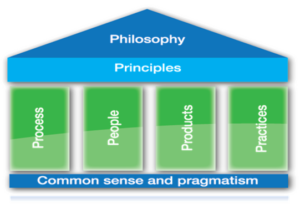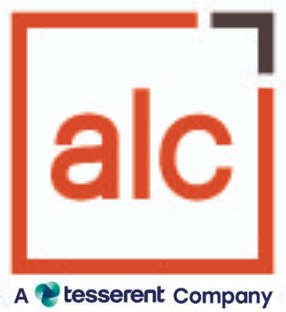First, what do we mean by Agile?
One way of explaining Agile is to consider the project management approach that it is not – it is not waterfall. Where does the term waterfall come from? It comes from picturing water falling downstairs, each stair representing a significant project phase or milestone. Just like gravity pulls water down with no loops, in waterfall projects once a phase is complete – it is considered done and generally costly or time consuming to modify if required.
What are some characteristics of waterfall? Effectively managed waterfall projects have stable requirements and a stable project environment, and while the products required can be complicated, once defined, business needs remain consistent. Waterfall projects typically require a high degree of outcome stability, consistency and certainty, regarding requirements and needs of the business.
The Waterfall methodology delivered projects effectively as the principle business change methodology – that is until the rise of markets that emphasised the importance of on time & on budget delivery, iterative development and incremental handover. It was at this time that things began to change – products and environments became more complex, projects encountered higher degrees of requirements uncertainty, and project competition increased. Delivering something on time became critically important and deploying incrementally rather than in large chunks aided to resolve uncertainty, compete effectively, and deliver early change benefits. Due to increased product complexity and the related higher degree of requirements, uncertainty change needed to be developed and agreed iteratively, as opposed to developing months and sometimes years of complicated functionality before deploying a significant release into production.
Within the umbrella of Agile project methods there are approaches for project management and product development. Scrum is a well-known Agile product development method, while it is very effective at capturing user needs and satisfying them through continuous change, it doesn’t normally consider a business case, schedule or requirements set from the perspective of the stakeholders responsible for a project-based investment. Scrum can be used very effectively with an Agile project management method and the two we are going to consider in this article are the Agile Business Consortium’s AgilePM® based on DSDM and Axelos’ PRINCE2® Agile.
So the question is –
Which one should you choose? AgilePM or PRINCE2 Agile?
Within Agile business change there are various approaches that are popular for project management and product development. In this article we are going to consider two of the more popular Agile project management methods, AgilePM and PRINCE2 Agile. We’ll overview the fundamentals of each and their similarities and differences.
Firstly, what do we mean by Agile project management? Project management is concerned with introducing business change driven by organisation goals or interests. This change could be new software, a new business process, updated responsibilities, or any technical and or non-technical changes to an organisation. Not every project-based change will be considered Agile, broadly project requirements are considered to be either waterfall (relatively stable requirements) or agile (requirements more subject to dynamic change). One of the key factors used to determine the difference between the two is complexity, namely how effectively requirements can be identified and agreed and how likely requirements are to change over time. The more complex your requirements, generally the more likely the need for dynamic and frequent change and an Agile project management approach. Agile project management approaches often include the terms iterative – involving the refinement of requirements over time and multiple reviews, and incremental – involving the deployment of finished features into production to enable progressive delivery of benefits and feedback. Both AgilePM and PRINCE2 Agile are iterative and incremental project management approaches and share similar characteristics critical to their effectiveness.
AgilePM®
AgilePM Foundation & Practitioner was initially developed in 1994 by the Dynamic System Development Method (DSDM) Consortium. The DSDM Method has since proven to be an effective framework for Agile project management and delivery, both within and since 2007 outside of the DSDM Consortium. DSDM brought together the best parts from traditional project management, such as control and quality, and rapid application development, namely good communication, business involvement and transparency. The following diagram summarises the structure of AgilePM.

The DSDM Philosophy sits like a roof or umbrella over a project managed according to AgilePM. Supporting the Philosophy is a set of 8 Principles that build the mindset and behaviours necessary to bring the Philosophy alive. The pillars of the DSDM composition diagram include an Agile Process, enabling an iterative and incremental project lifecycle, People fulfilling defined roles and responsibilities, clearly defined and prioritised Products, and recommended and agreed Practices.
AgilePM has proven to be highly effective for organisations that need to efficiently deploy a flexible, adaptable agile project management approach, particularly where the organisation has limited project management governance.
>> Explore ALC’s AgilePM Foundation & Practitioner course for detailed information.
PRINCE2 Agile®
Projects in Controlled Environments (PRINCE2) is uniquely regarded as the most commonly used project management approach in the world, particularly for waterfall requirements projects. In the mid 2000’s it was recognised that project management organisations increasingly required a tailored version of PRINCE2 suitable for use with Agile product development methods, such as Scrum and Kanban. As a result, a project was launched to create a version of PRINCE2 tailored to projects delivering Agile solutions, and PRINCE2 Agile was born.
Similar to AgilePM, PRINCE22 Agile is driven by tailored Principles. It includes Processes that are used at a project management level for project governance, and Themes that include the Practices and Products recommended for Agile Project Management roles and responsibilities. While PRINCE2 Agile can be used with AgilePM, the tailored PRINCE2 Agile framework is principally pitched at projects being managed overall by PRINCE2 with product development based on a common Agile product delivery approach, such as Scrum or Kanban.
PRINCE2 Agile is ideal for organisations that use PRINCE2 to manage project-based investments and have adopted Agile practices or may be encountering Agile practices in the future. Table 3.1 from the PRINCE2 Agile guide provides an overview of the business change communities on which PRINCE2 Agile is focused.
Table 3.1 The Communities on which Prince2 Agile is focused
| Focus of Prince2 Agile | Community | Description | Possible goals |
| Primary | PRINCE2 wanting to adopt (more) agile | PRINCE2 organisations, departments or individuals who wish to adopt agile. | They wish to integrate agile into their existing PRINCE2 working practices in order to benefit from this way of working. |
| Primary | PRINCE2 encountering agile | PRINCE2 organisations, departments or individuals who are encountering other organisations, departments or individuals using agile in some form. | They wish to understand what agile is and how it works so that they can tailor PRINCE2 appropriately and integrate with it. |
| Primary | PRINCE2 practicing agile | PRINCE2 organisations, departments or individuals who are practicing agile in some form. | They wish to adopt a formal standard for using agile in a PRINCE2 context. |
| Secondary | Agile wanting to adopt PRINCE2 | Organisations, departments or individuals who have some agile experience and wish to adopt PRINCE2. | They wish to adopt an industry standard approach to project management and project governance to complement their existing agile working practices. |
| Possible area of focus | Mature agile | Organisations, departments or individuals who have adopted agile and have reached high levels of maturity for both BAU and project work. | They wish to become familiar with Prince2 Agile in order to add to their existing body of knowledge. |
For organisations with an established approach to using PRINCE2 to manage projects and a need to effectively guide agile business change, PRINCE2 Agile should be most beneficial. Investing in the adoption of PRINCE2 Agile will enable an organisation to further leverage the value of PRINCE2 and improve Agile project governance.
Choosing PRINCE2 Agile or AgilePM
Which of the two approaches should you consider if your organisation needs an agile project management framework?
Some questions to think about:
Does my organisation currently use PRINCE2?
- If yes, PRINCE2Agile will provide the guidance to tailor PRINCE2 for Agile projects.
- If no your organisation will most likely find AgilePM easier to adopt
Is my organisation / team experienced with agile project management concepts?
- If your team has limited experience with Agile and needs to learn about Scrum, Kanban, and broader Agile concepts PRINCE2Agile will be slightly more helpful
- An experienced team seeking improved project management governance will find AgilePM a little less costly and time consuming to adopt.
In summary it’s important to note that both AgilePM and PRINCE2 Agile are proven agile project management approaches and can both be tailored to meet an organisation’s project management requirements. In rare circumstances they can even be used together to effectively manage organisational change.
The approach that you select will largely depend on your organisation’s current project management experience and project management methods as summarised following:
AgilePM – pros, specifically developed for Agile projects. Proven track record of success over many years. Works well with Scrum. Cons – if your organisation is Prince2 project management method focussed AgilePM will be another method with different language, introducing extra project management overhead and complexity.
PRINCE2 Agile – pros. Prince2 is the world’s most popular project management method. Prince2 Agile has been specifically tailored to work with the most popular agile product development methods, including Scrum, Kanban, and Lean Startup. Cons – significant investment to adopt tailored Prince2 if your organisation is starting to develop its project management methods from scratch, AgilePM is designed to get started faster with less effort.

